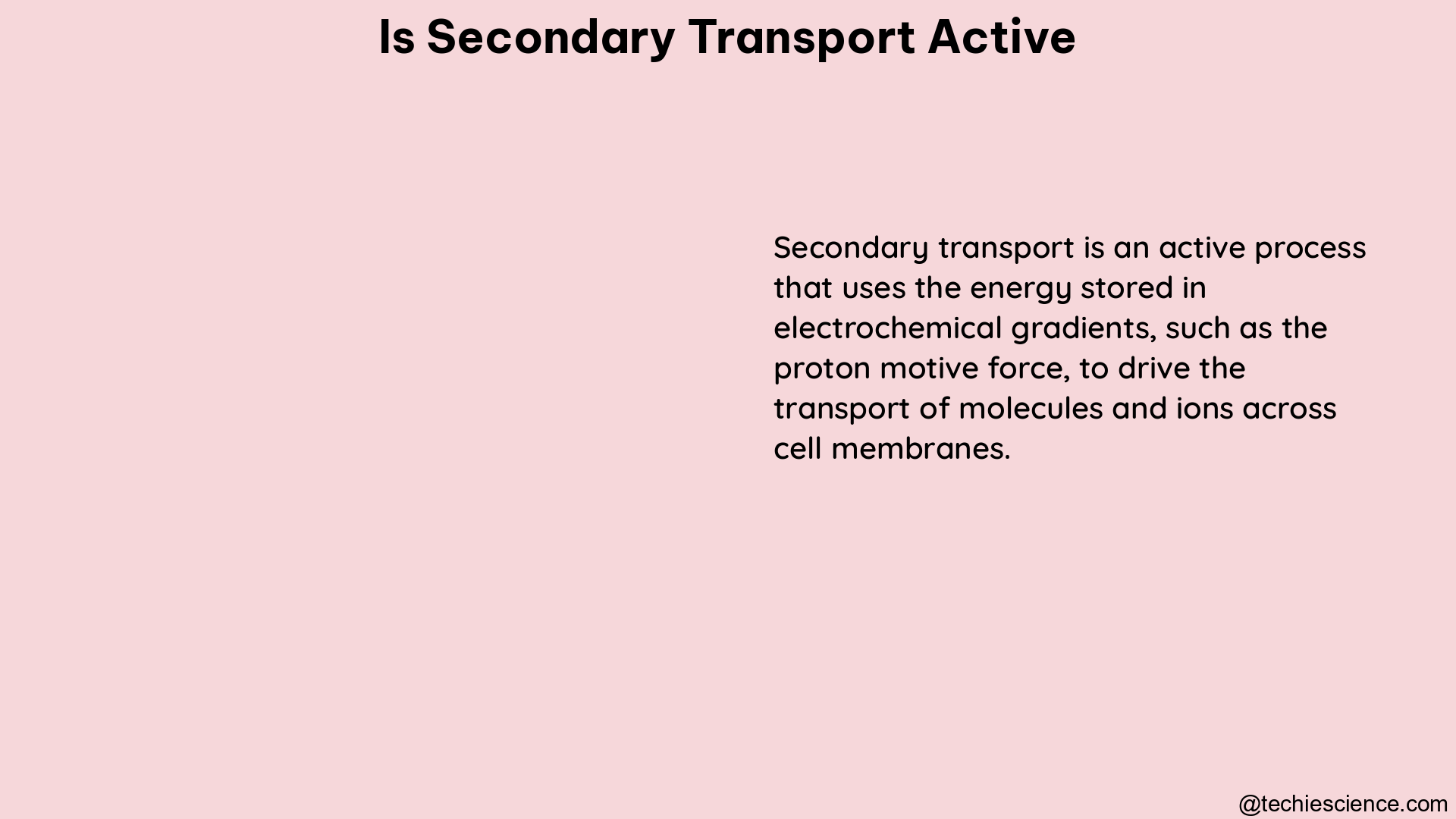Secondary active transport is a crucial process in cellular biology that allows cells to maintain concentration gradients of various ions and molecules, which is essential for many cellular processes. This process uses the energy stored in electrochemical gradients to move other substances against their own gradients, indirectly driven by metabolic energy.
Understanding the Mechanism of Secondary Active Transport
In secondary active transport, the energy stored in the electrochemical gradient is released as ions move back down their gradients, and this energy is used to transport other substances uphill. This process is characterized by the use of a shared carrier protein, known as a cotransporter, which allows one type of ion (e.g., sodium ions) to move down its gradient while simultaneously transporting another substance (e.g., glucose, amino acids, or neurotransmitters) in the opposite direction.
The two molecules being transported may move in the same direction, in which case the protein that transports them is called a symporter, or in opposite directions, in which case the protein is called an antiporter. This mechanism allows cells to maintain concentration gradients of various ions and molecules, which is essential for many cellular processes, such as:
- Nutrient Uptake: Sodium-glucose cotransporters (SGLT) in the intestine and kidney use the electrochemical gradient of sodium ions to drive the uphill transport of glucose and other nutrients into the cell.
- Neurotransmitter Reuptake: Sodium-dependent neurotransmitter transporters in the synaptic cleft use the sodium ion gradient to drive the reuptake of neurotransmitters, such as serotonin, dopamine, and GABA, back into the presynaptic neuron.
- Ion Homeostasis: Sodium-potassium ATPase (Na+/K+ pump) uses the energy from ATP hydrolysis to maintain the electrochemical gradient of sodium and potassium ions across the cell membrane, which is essential for many cellular processes, such as nerve impulse propagation and muscle contraction.
Quantifying Secondary Active Transport

To characterize the function of secondary active transporters, several descriptors can be used:
- Rate of Substrate Uptake: This measure the initial rate of substrate uptake by the transporter, which can be influenced by factors such as substrate concentration, membrane potential, and the availability of the cotransported ion.
- Maximum Rate of Substrate Uptake (Vmax): This represents the maximum rate of substrate transport that the transporter can achieve, which is determined by the kinetic parameters of the partial reactions in the transport cycle.
- Inhibition Constant (Ki): This describes the potency of an inhibitor in reducing the activity of the transporter, and it can be used to identify the partial reaction(s) that are most likely altered in a given catalytic variant of the transporter.
These descriptors can be related to the partial reactions in the transport cycle, and they can be used to predict how altered partial reactions affect the values of these descriptors. For example, changes in the rate-limiting partial reaction(s) can significantly impact the Vmax and Ki of the transporter.
Factors Affecting Secondary Active Transport
Several factors can influence the efficiency and activity of secondary active transporters:
- Electrochemical Gradient: The magnitude and direction of the electrochemical gradient of the cotransported ion (e.g., sodium, proton) can significantly affect the rate and direction of substrate transport.
- Membrane Potential: Changes in the membrane potential can alter the driving force for the cotransported ion, thereby affecting the overall transport process.
- Substrate Concentration: The availability and concentration of the transported substrate can influence the rate of transport, as the substrate must bind to the transporter to be transported.
- Transporter Expression and Localization: The abundance and subcellular localization of the secondary active transporter can determine the overall capacity and efficiency of the transport process.
- Regulatory Mechanisms: Posttranslational modifications, allosteric regulation, and interactions with other cellular components can modulate the activity and function of secondary active transporters.
Understanding these factors is crucial for predicting and manipulating the behavior of secondary active transporters in various biological contexts, such as drug delivery, nutrient absorption, and neurotransmitter regulation.
Applications and Implications of Secondary Active Transport
Secondary active transport plays a vital role in numerous physiological processes and has important implications in various fields, including:
- Pharmacology and Drug Delivery: Understanding the mechanisms of secondary active transport can aid in the design of more effective drug delivery systems, as transporters can be targeted to facilitate the uptake of therapeutic agents into cells or specific tissues.
- Nutrition and Metabolism: The role of secondary active transporters in nutrient absorption and utilization is crucial for maintaining overall health and metabolic homeostasis.
- Neuroscience: The function of secondary active transporters in the regulation of neurotransmitter levels and ion homeostasis is essential for proper neuronal communication and brain function.
- Cellular Signaling and Homeostasis: The maintenance of electrochemical gradients and the transport of various ions and molecules through secondary active transporters are fundamental to many cellular signaling pathways and homeostatic mechanisms.
- Biotechnology and Bioremediation: Secondary active transporters can be engineered or exploited for applications in biotechnology, such as the development of biosensors or the remediation of environmental pollutants.
In conclusion, secondary active transport is a complex and dynamic process that plays a crucial role in cellular function and homeostasis. By understanding the mechanisms, quantifiable descriptors, and factors that influence secondary active transport, researchers and clinicians can develop more effective strategies for addressing a wide range of biological and medical challenges.
References:
- Bio.libretexts.org, 5.12: Active Transport – Secondary Active Transport. Available at: https://bio.libretexts.org/Bookshelves/Introductory_and_General_Biology/General_Biology_%28Boundless%29/05:_Structure_and_Function_of_Plasma_Membranes/5.12:_Active_Transport_-_Secondary_Active_Transport
- Mdpi.com, Descriptors of Secondary Active Transporter Function and How They Relate to the Partial Reactions in the Transport Cycle. Available at: https://www.mdpi.com/2077-0375/11/3/178
- Sciencedirect.com, Primary Active Transport – an overview. Available at: https://www.sciencedirect.com/topics/engineering/primary-active-transport
- Khanacademy.org, Active transport: primary & secondary overview. Available at: https://www.khanacademy.org/science/ap-biology/cell-structure-and-function/facilitated-diffusion/a/active-transport
- Quizlet.com, BISC 207: Mini-Exam 2 Flashcards. Available at: https://quizlet.com/537339397/bisc-207-mini-exam-2-flash-cards/

Hi…I am Arti Pandey, have a Master’s degree in Biotechnology. I am an academic writer in Lambdageeks and also a beginner Korean learner. I love to explore new cultures, places, and food. I love photography and had a keen interest in creative writing.